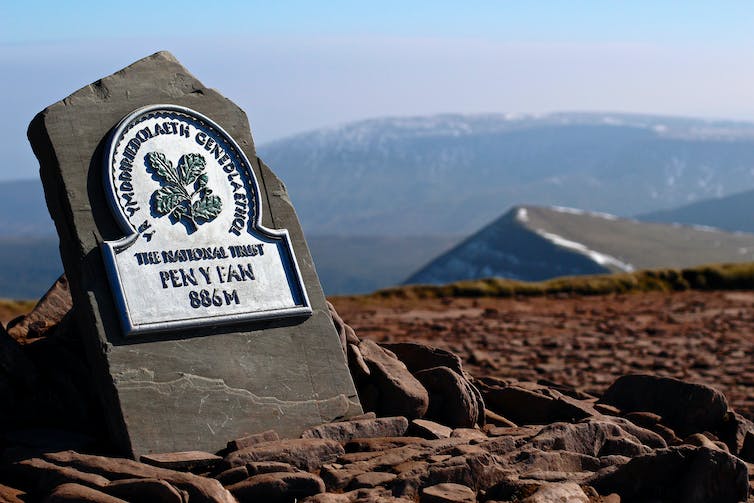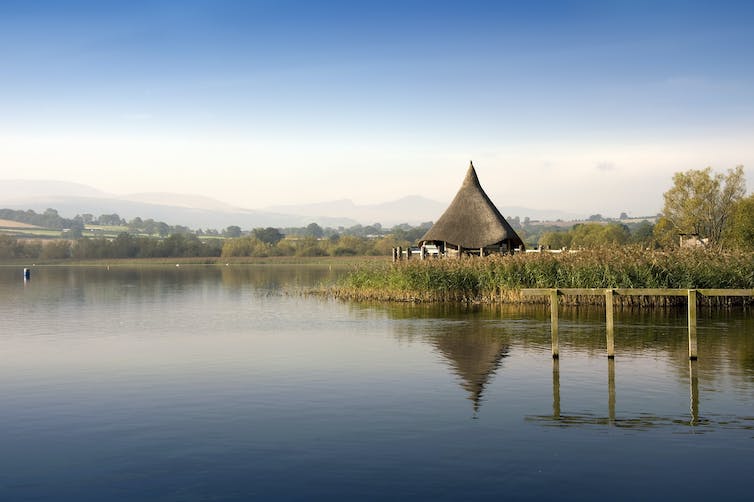The Brecon Beacons National Park is now formally solely identified by its native Welsh identify. Mel Manser Photography/Shutterstock
You can even learn this text in Welsh.
On its 66th birthday, Bannau Brycheiniog National Park launched a brand new administration plan looking for to fight its biggest challenges: the character and local weather emergencies. This plan contains initiatives to plant timber, shield endangered species and their habitats, and enhance the standard of its rivers.
But regardless of the most effective efforts of a promotional video that includes the actor Michael Sheen, one other facet of the plan has generated most curiosity. From now on, the nationwide park will use solely its Welsh identify, Bannau Brycheiniog, fairly than Brecon Beacons.
Michael Sheen describes Bannau Brycheiniog as ‘a reputation from our previous, to take us into our future’.
In actuality, little has modified. Bannau Brycheiniog was all the time the Welsh identify for the park, used because it was established in 1957. Indeed, the primary particular person to check with Bannau Brycheiniog in writing was the poet and antiquary John Leland, who lived throughout the first half of the sixteenth century.
Leland was an avid traveller and undertook a number of journeys round Wales and England. He took detailed notes of what he noticed, heard and realized. One of his journeys took him to the mountains of south Wales and he described the mountain, Pen-y-Fan, in his notes. Leland wrote that that there have been many “numerous hilles” and collectively they have been referred to as “Banne Brekeniauc” (sic).

Pen-y-Fan is the best summit in south Wales.
Edd Mitchell/Shutterstock
In Welsh, bannau is the plural of ban, which suggests “summit” or “peak”, and is a standard identify for “mountain”. We can see a number of mountains so-named within the nationwide park immediately, together with Pen-y-Fan, Fan Fawr and Fan Hir. Around Leland’s time, we regularly see references to Y Fan (a single mountain) and Y Bannau (a group of mountains). These names are widespread and it’s usually tough to know exactly which mountains are being described.
Poetry
For different examples, we are able to flip to the work of the Welsh poets. In the fifteenth century, Ieuan Llawdden composed Moliant Brycheiniog (In Praise of Brycheiniog). As its title suggests, the poem is a celebration of Brycheiniog’s rivers, timber, saints, inhabitants and mountains. The poem encompasses the area “o’r Fan hyd ar Y Fenni” (“from the Fan so far as Y Fenni”).
In an elegy composed within the sixteenth century, Lewys Morgannwg writes that all over the place is unhappy “o Hafren i’r Bannau” (“from the Severn to the Bannau”).
And a poem by a bard often known as Y Nant (the Stream) from the fifteenth century features a reference to “tu yma i’r Banne” (“this aspect of the Bannau”). We don’t know the poet’s actual identify or something about them, however their poems are filled with references to the individuals and locations of Brycheiniog.
These have been poets not cartographers, after all, writing poems not designing maps. We shouldn’t count on them to have described the placement of each identify they point out particularly. But there’s clearly a practice of referring to the mountains of Brycheiniog as Y Bannau.
A medieval kingdom
Brycheiniog was a medieval kingdom in south-east Wales. It was widespread so as to add suffixes reminiscent of -iog or -ion to a private identify to point “the individuals of”, “the descendants of”, or “the territory held by”. We see this within the up to date county of Ceredigion, which is the non-public identify Ceredig with the suffix -ion, and in Brycheiniog, with the non-public identify Brychan and the suffix -iog.
Brychan was a Fifth- or Sixth-century king who, based on medieval lore, got here from Ireland. He was additionally allegedly the daddy of tens of youngsters, a lot of them saints, together with the Welsh patron saint of affection, Dwynwen.

A view of Llyn Syfaddan and its crannog, constructed by the king of Brycheiniog.
Robert Harding/Shutterstock
It have to be confused that these are later tales – we don’t know something for certain concerning the historic Brychan. But there’s proof of Irish affect on the land of Brycheiniog within the center ages. For instance, there are a variety of stones inscribed with ogham, an alphabet used for writing Irish, and these embrace Irish names.
In the tenth century, the king of Brycheiniog constructed a crannog (synthetic island) on Llyn Syfaddan (Llan-gors Lake). This is the one instance of a medieval crannog in Wales, however they’re widespread in Ireland and Scotland. Whatever Brychan’s historical past, it’s doubtless that actual connections with Ireland impressed the tales about his Irish background.
Reclamation
The lack of Welsh place-names is a matter of accelerating concern. As early because the twelfth century, the cleric, historian and traveller Gerald of Wales complained that the place identify Llanddewi Nant Honddu was being corrupted to Llanthony.
More not too long ago, teams such because the Welsh Place-Name Society have been working tirelessly to guard Welsh names. Bannau Brycheiniog follows Eryri because the second nationwide park to decide to utilizing solely its Welsh model.
And it isn’t only a matter of language both. The park feels the identify Bannau Brycheiniog is “extra in step with its Welsh heritage”. But amid each nature and local weather emergencies, way more have to be finished to guard this treasured place and its wealthy historical past.
![]()
Rebecca Thomas is Bannau Brycheiniog National Park's Welsh author in residence (2022/3).
